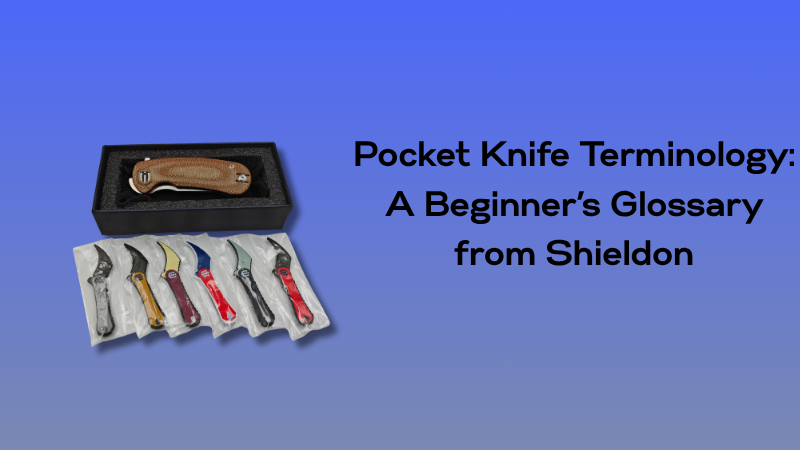
Pocket Knife Terminology: A Beginner’s Glossary from Shieldon
If you're just beginning your journey into the world of knives, you've probably come across a variety of unfamiliar terms. Knife enthusiasts and collectors have developed their own unique vocabulary to describe blades and their components. While it can seem confusing at first, understanding this language will enhance your appreciation and selection process.
To help you get started, we've created a glossary of the most commonly used terms associated with the Pocket knife. Whether you’re shopping for your first Folding Knife or simply want to learn more, this guide offers essential insights into knife terminology.
Common Knife Terms You Should Know
Back
The unsharpened spine of the blade. It’s more than just visual balance—it provides structural support and serves as a grip point during tougher tasks.
Bail
A small loop-shaped fixture at the base of the knife. This allows users to attach cords or clips, making it easier to carry and less likely to drop the knife unintentionally.
Belly
The curved edge of the blade used for slicing. A fuller, rounded belly offers more surface area for cutting, which improves performance on slicing tasks.
Blade Bevel
This is the tapered section that leads to the cutting edge. It usually starts near the handle and narrows toward the blade’s tip, forming the edge that does the cutting.]
Blade Lock
A critical component of any Folding Knife, this mechanism secures the blade in place once it's open. Different knives feature varying types of locks, each offering unique safety and usability benefits.
Bolsters
These are metal fittings between the blade and the handle, typically made of brass or stainless steel. They serve both a decorative and practical purpose—mainly to prevent the user's hand from slipping onto the blade.
Carbon Steel
A blend of steel and carbon (around 85% and 15% respectively), this material creates extremely hard blades. High-carbon steel knives often require more care but reward the user with durability and long-lasting sharpness.
Choil
An unsharpened section near the base of the blade. It’s often used as a finger rest or grip point for more precise control during fine tasks.
Clip Blade
Popular in American-style knives, this blade shape has a concave curve from the spine to the tip. It’s well-suited for everyday tasks and even some tactical uses.
Concave Grind
A grind that arches inward from the spine to the cutting edge. While easy to sharpen, it's more delicate and susceptible to chipping if misused.
Crink
The internal material supporting the structure between the bolsters and liners. It helps maintain grip integrity and overall knife stability.
Damascus Steel
This steel is formed by layering and forging soft and hard steels together. Known for its beautiful patterns and high flexibility, it's commonly used in premium Shieldon knife models.
Flat Grind
A grind that slopes uniformly from the spine to the cutting edge. Many EDC knife designs feature this grind due to its versatility and control.
Guard
Located where the blade meets the handle, this feature prevents your hand from sliding forward and making contact with the sharp edge.
Hollow Grind
Formed when the blade’s bevel curves inward, making the edge razor-sharp. This style is common in tactical and Martial Arts knife designs due to its cutting efficiency.
Lanyard
A cord or leather strap attached to the knife’s handle. It’s used to secure the knife to your wrist, belt, or gear, ensuring quick access and preventing loss.
Liner
This part sits inside the handle and supports the opening and closing motion of a Folding Knife. It also reinforces the frame’s structure and helps protect the blade.
Retention
Describes how well a blade maintains its edge over time. High retention means fewer sharpening sessions and longer-lasting performance—something Shieldon knives are specifically engineered to deliver.
Takeaways
Learning knife terminology can make you a more informed buyer and more confident user. As you become more experienced, you'll encounter many more specialized terms that describe different grinds, handle styles, locking systems, and more.
Whether you're interested in collecting knives, using them for outdoor activities, or training with a Martial Arts knife, expanding your knife vocabulary enhances the entire experience.
To explore high-quality knives engineered with attention to detail, visit Shieldon’s official website. You’ll find a full lineup of expertly designed tools—from durable Folding Knives and compact Pocket knives to reliable EDC knives for everyday use.

